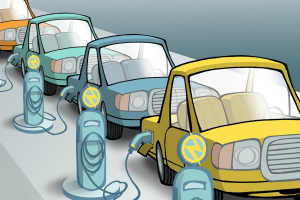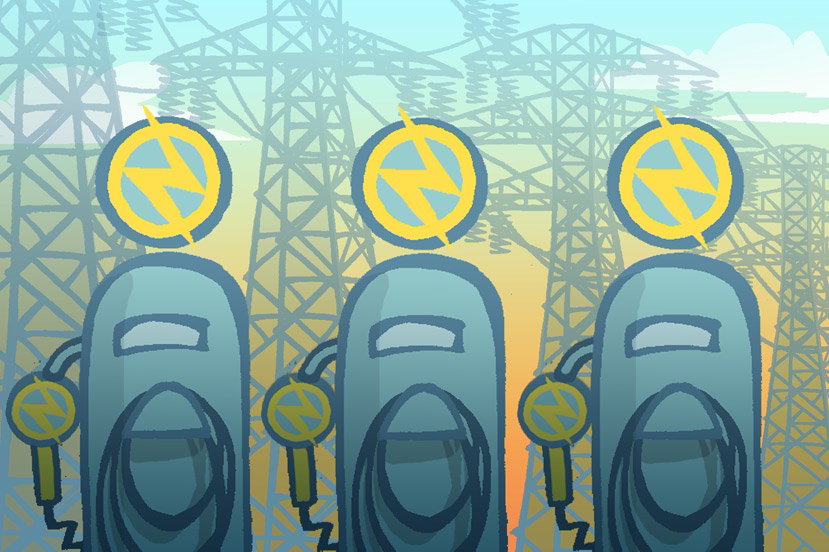Off-Peak Charging Can Minimize Grid Impacts, Aid Grid Balancing
Jim Avery sounds Dickensian as he talks about the possible grid impact of charging tens of millions of new electric vehicles. “It could be the best thing to happen to the industry—or the worst,” said Avery, who is San Diego Gas & Electric’s (SDG&E) chief development officer.
Avery’s tale of two grid futures is based on straightforward math. He explains that California’s peak load of about 60,000 megawatts can be expected to grow dramatically by 2050, based on the projected population increase from 30 million to 50 million, coupled with the state’s ambitious targets to reduce greenhouse gas.
Avery expects the targets to drive extensive electrification of the transportation system, including passenger cars, light and heavy trucks, and railroads. Consider passenger cars. Assuming today’s ownership level of one car per Californian, there could be 50 million cars in 2050. “Let’s further assume that three-fifths of these 50 million vehicles will require some level of charging,” said Avery. “That’s 30 million full electric or hybrid vehicles. If these 30 million vehicles consume 4 kilowatts during a typical charge and they all charge in the evening when demand is highest, that’s a total of 120,000 megawatts—or twice the current peak load. That could strain a utility’s ability to keep up with demand, but it also offers an exciting opportunity.”
A Program to Encourage Off-Peak Charging
When charging electric vehicles, timing is everything. If 30 million drivers plug in during peak demand, utilities would need to make large investments in new generation and grid infrastructure. If those drivers charged during off-peak times, such investments may not be necessary.
With this in mind, SDG&E in 2014 proposed a pilot program to supply chargers to the public while influencing when people charge. In January, the California Public Utilities Commission approved SDG&E’s Electric Vehicle-Grid Integration program, which will enable SDG&E to install 3,500 new chargers at businesses and multi-family residential complexes throughout its Southern California service territory. It would feature special rates to encourage charging during off-peak hours in the middle of the day, when renewable energy is plentiful. Customers could use a mobile phone app to schedule charging when the price is low.
“When planning for the future, it’s critical for utilities to think about how to influence charging behavior,” said Avery. “Our pilot could help meet the increased load demand from millions of new electric vehicles with relatively minimal impact on the grid.”
Preparing for Droves of Electric Vehicles
SDG&E’s program points to the conditions necessary for charging electric transportation on a large scale. One is a widespread network of public chargers. “Electric vehicles will flourish when there’s enough public infrastructure so people can drive around and feel comfortable that they won’t be stranded,” said Mark Duvall, director of electric transportation at EPRI.
Equally important is timing of charging. “Today, each electric vehicle has a relatively high grid impact,” said Duvall. “Many drivers are on a flat rate, and there are no incentives to charge at off-peak times. So they plug in when they arrive home at 5 or 6 in the evening during peak demand. That behavior is okay when there are few electric vehicles, but it’s not sustainable when there are millions and millions of them.”
A New Tool for Balancing the Grid
Off-peak charging can potentially help grid operators balance demand and generation. “What’s in an electric vehicle?” said Tom Reddoch, who manages energy utilization research at EPRI. “A battery that can be used for electric storage to hold excess generation.” Pumped storage hydroelectric facilities are commonly used to store excess electricity from baseload nuclear and fossil power plants. As more variable solar and wind power capacity is deployed, electric vehicles can provide a similar service, storing excess generation during the sunniest or windiest periods.
“With electric vehicles, utilities have another potential balancing agent, which could be valuable in a future with cleaner electricity,” said Reddoch.
With respect to the grid’s ability to charge millions of vehicles, Reddoch is an optimist. In part, this reflects efforts to optimize charging times for more efficient grid operations. But it also reflects the electric power industry’s demonstrated ability to handle challenges of this scale and complexity. “In the past 25 years, the most significant electric load to hit the grid has been air conditioning and heat pumps, which consume more energy per unit than any electric vehicle,” he said. “So what’s the big fuss? As long as we account for the new load in our operations, it’s not a big deal.”
Key EPRI Technical Experts:
Dan Bowermaster
For more information, contact techexpert@eprijournal.com.
Artwork by Kirk Anderson




